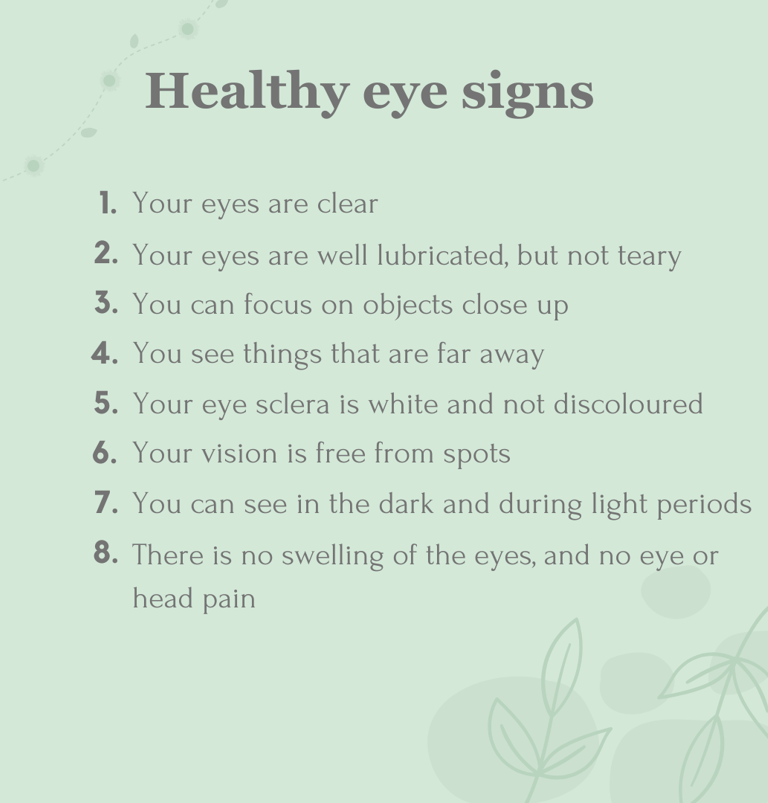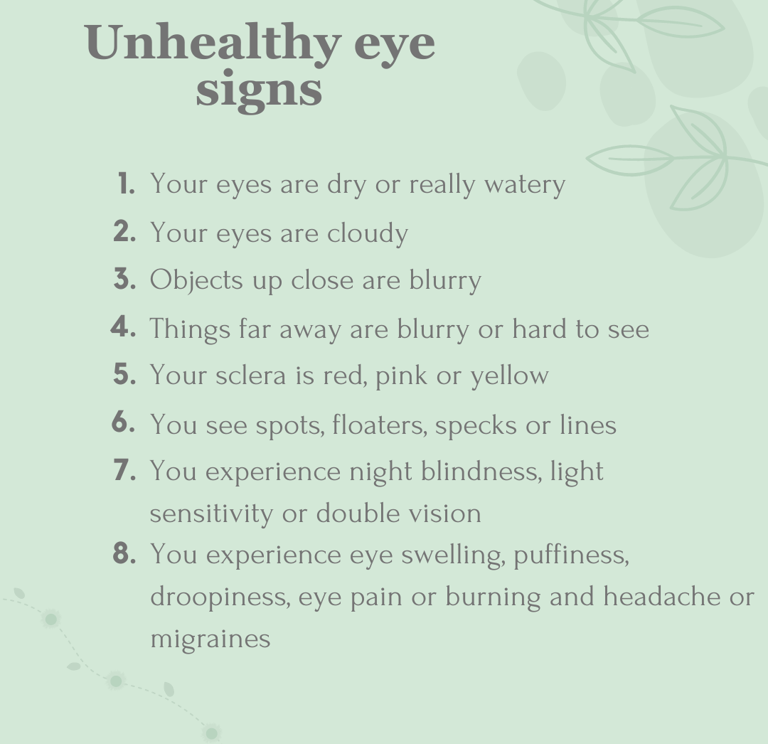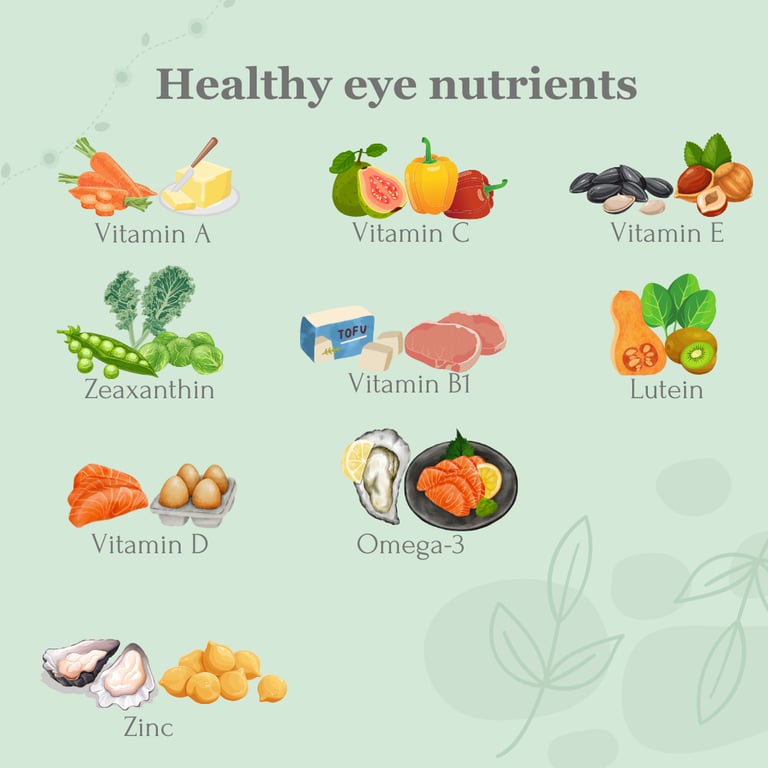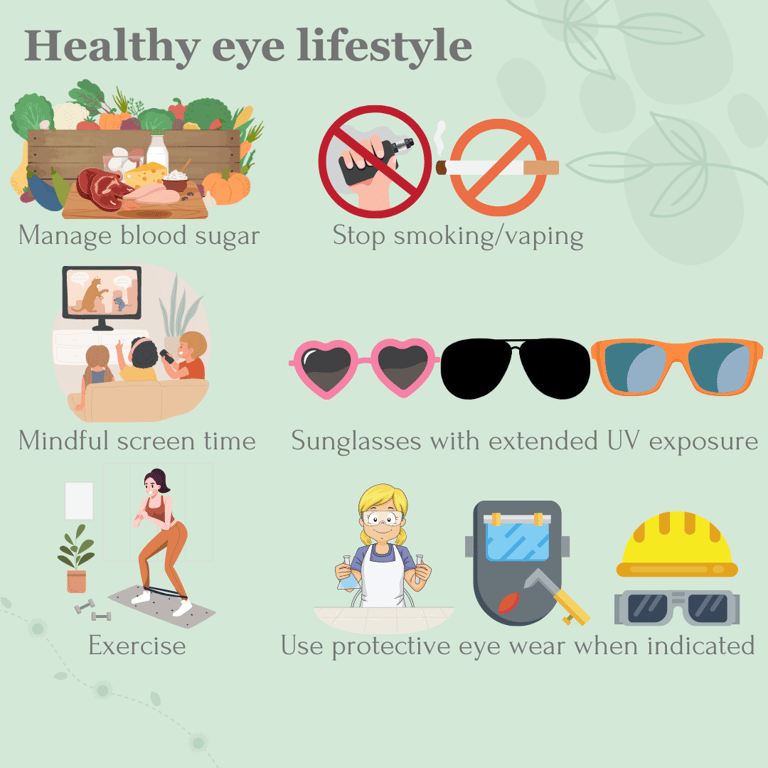
Full Body Health: Eyes
A deep dive into eye health with nutritional and lifestyle tips


What are the eyes?
The eyes are important organs that give us our sense of sight. Our eyes work closely with our brain to process and interpret sight. The eyes are made up of many different parts that work together to allow us to see.
The Conjunctiva is a protective covering of the eye that lines the inside of the eyelids and covers the sclera. It also lubricates the eye and is responsible for producing mucus and tears. The Lacrimal gland and the Meibomian gland are also involved in tear production that helps protect the eyes. Tears are drained from the eye via the Tear Duct. The Cornea is responsible for focusing light into the eye. The cornea is kept lubricated and protected by the tears produced by the conjunctiva. The Iris is the coloured part of the eye and the dark centre of the iris is the Pupil. The pupil and iris dilate or constrict to change the amount of light that enters the eye. Lighter coloured eyes may experience more light sensitivity, due to light coloured eyes not being as effective at blocking out light as darker coloured eyes. During periods of bright or direct light, the pupils constrict to reduce the amount of light entering the eye to avoid damage. Behind the pupil is the Lens, the lens focuses light towards the back of the eye. It also changes shape to focus on objects up close or far away. Most people think the lens plays the most important role in vision, however, the lens is only responsible for 30% of focusing power while the cornea is responsible for 70% (1). The Sclera is the white part of the outer eye that surrounds the iris. The sclera is responsible for the eyes shape and acts as a protective structure for the internal structures of the eye.
In the centre of the eye, behind the lens, is a cavity filled with a jelly like substance known as Vitreous Humor. This substance also helps to give shape to the eye. At the back of the eye is the Retina is a nerve layer that converts light into electrical signals that are sent to the brain via the Optic Nerve. The retina contains a specialised area called the Macula, which is responsible for seeing fine details and colour. The retina actually sees things upside down and our brain interprets visual signals and turns them the right way up. The brain is responsible for interpreting the electrical impulses from the retina and optic nerve and provides a clear picture of what we see.
Eye signs and symptoms




Eye signs and symptoms can indicate that the eyes may not be at their healthiest. Not all eye symptoms point to something severe, however, all symptoms or signs should be investigated to have conditions ruled out. If you have any signs or symptoms you are concerned about, please have these investigated by a doctor, optometrist or opthalmologist. Sudden loss of vision or severe and sudden symptoms should be treated as a medical emergency.
Some symptoms related to the eyes include:
Blurry vision
Dry eyes
Excessively watery eyes
Red, pink or yellow sclera
Spots, floaters, specks or line in vision
Double vision
Loss of colour/dullness of colour in vision
Trouble focusing on objects close up or far away
Flickering eyes (nystagmus)
Headaches or migraines
Eye pain
Discharge or crust build up in or around eyes
Swelling of any part of the eye or surrounding structures
Auras or glare in vision
Light sensitivity
Drooping of eyelids or unable to close eyes
Crossed eyes
Different sized pupils
Reduced depth perception
Redness of the eye or surrounding structures
Loss of vision
Trouble seeing at night
Excessively itchy eyes
Restricted eye movement
Changes in iris colour
Cloudy appearance of eyes
Eye diseases and disorders
Not all of the following disease and disorders affect only the eyes and many are impacted by other factors other than just the eyes. Some symptoms that impact the eyes are caused by diseases and disorders that involve other body systems.
Long-sightedness
Short-sightedness
Astigmatism
Presbyopia
Cataracts
Diabetic Retinopathy
Age-related Macular Degeneration (AMD)
Glaucoma
Multiple Sclerosis
Retinal Detachment
Corneal Ulcer
Conjunctivitis
Styes
Blepharitis
Allergies
Uveitis
Strabismus
Keratoconus
Amblyopia
Dry eye
Graves' Eye Disease
Eye Injuries
Bell's Palsy
Stroke
Migraine
Blocked tear duct
Scleritis
Nutrition for eye health


Nutrition can play an important role in optimizing eye health and supporting eye function, as well as aiding in symptom management or improvement in some eye conditions. The nutrients and food listed here is general advice for supporting eye health. It is always best practice to include wholefood sources of these foods over supplements. Wholefood sources often have other nutrients that aid in absorption or benefit the recommended nutrients. Supplements should only be taken under the guidance of a qualified health professional. If you have a specific symptom or condition you would like help with. Please consult a qualified health professional. If you would like to see if I can help you, please either book a discovery call or email me.
Vitamin A: There are two main forms of Vitamin A. Retinol or Retinyl Esters are the bioavailable forms of vitamin A. Provitamin A carotenoids, such as beta-carotene, are converted to retinol in the human body but they are not converted in high amounts. Beta-carotene offers other beneficial properties to both eye and general health and are still an important component of the diet. Vitamin A is involved in converting the light signals that the retina receives into electrical signals to send to the brain. Vitamin A deficiency is known to impact vision, especially night blindness. Vitamin A deficiency has also been associated with dry eyes.
Food sources: Beef liver, Cod liver oil, Salmon, Butter, Eggs, Sweet potato (beta-carotene), Spinach (beta-carotene), and Carrots (beta-carotene).
Vitamin C: Vitamin C is an antioxidant that protects against reactive oxygen species (ROS) and oxidative stress. Vitamin C is found in the aqueous humor of eye at higher concentrations than that of plasma. Vitamin C is also important to regenerating Vitamin E, another important nutrient for eye health. Vitamin C is believed to have a protective role in eye health as when we age, Vitamin C levels in the eye decrease. Vitamin C deficiency in the eye has been linked with cataracts, AMD and other ocular disease.
Food sources: Kakadu Plums, Guava, Strawberries, Kiwi Fruit, Capsicum, Oranges, Broccoli and Papaya.
Vitamin E: Vitamin E is another important antioxidant with high concentrations found in the retina of the eye. Vitamin E is important in the retina as it protects against lipid oxidation. Vitamin E helps to maintain retina function and structure, even more so when levels of other antioxidants are optimal. Vitamin E may assist with ocular diseases, including Retinal Oedema and AMD.
Food sources: Sunflower seeds, Almonds, Peanuts + Peanut Butter, Avocados, Spinach, Kiwi Fruit, Salmon and Pumpkin.
Lutein and Zeaxanthin: Lutein and Zeaxanthin are two types of carotenoids that play an important and protective role in eye health. They are both found in high concentrations of the macula of the retina and are involved reducing the oxidative stress caused by exposure to UV radiation by absorbing blue light. Lutein and Zeaxanthin also improve contrast sensitivity and therefore improve vision. Lutein and Zeaxanthin's antioxidant properties can help prevent AMD by reducing retinal photooxidation and other oxidative stress that result in macular degeneration. They also help to prevent other eye disease such as cataracts and diabetic retinopathy.
Food sources: Kale, Parsley, Spinach, Broccoli, Peas, Oranges, Kiwi Fruit, Capsicum, Pistachios, Carrots, and Grapes.
Vitamin B1: Vitamin B1 is important in reducing oxidative stress via its role in increasing glutathione. Glutathione concentrations are quite high in the eyes, particularly the lens. Vitamin B1 has been associated with reducing the risks of Cataracts and Diabetic Retinopathy. Vitamin B1 has also been found to help relieve Dry Eye symptoms.
Food sources: Pork, Salmon, Flaxseeds, Green Peas, Tofu, Brown Rice, Asparagus and Mussels.
Vitamin D: Vitamin D has anti-oxidant and anti-inflammatory properties that act as a protective mechanism against many ocular diseases and help to preserve eye health. Optimal Vitamin D levels may help prevent AMD, Glaucoma, Diabetic Retinopathy, Dry Eye, Graves' Eye Disease, Uveitis and Cataract. The main ways vitamin D may prevent these diseases are via reducing inflammation and oxidative stress, increasing insulin sensitivity and modulating the immune system.
Food sources: Eggs, Cod Liver Oil, Salmon, Tuna, Sardines, Beef Liver, and Fortified Dairy
Omega-3: Long-chain Omega-3 fatty acids (EPA & DHA) are essential to consume as our body cannot endogenously make them. Omega-3, particularly DHA, is important for eye health due to its anti-inflammatory properties and its role in supporting the structure and function of the retina. Dietary Omega-3 intake may help to reduce Dry Eye symptoms and prevent AMD.
Food sources: Salmon, Mackerel, Tuna, Herring, Sardines, Flax and Chia seeds, and Walnuts.
Zinc: Zinc has many important roles throughout the body, including in eyes! Zinc is found in high concentrations in the eye, particularly retina. Zinc protects the retina by being a co-factor for enzymes needed for the metabolism of the eye, including reducing oxidative damage. Zinc also has a close relationship with Vitamin A and deficiency can impact Vitamin A movement out of the liver. Zinc may help with Night Blindness and AMD prevention.
Food sources: Beef, Beef Liver, Oysters, Chickpeas, Beans, Hemp Seeds, Cashews and Eggs.
Lifestyle for eye health


Lifestyle can play an important role in eye health and prevention of eye related diseases. These lifestyle tips can take some time to implement and create the habit, so go slowly and implement the ones that work best for you or feel achievable at the moment. This is not an exhaustive list of lifestyle habits to support eye health, but it is a good place to start.
Manage blood sugar: As mentioned earlier, Diabetic Retinopathy is an eye disease that is caused by diabetes. More than half of those who suffer from diabetes, have Diabetic Retinopathy. While Diabetic Retinopathy can occur with any type of diabetes, Type 2 diabetes is the one we will be focusing on as this one can be prevented and managed with diet and lifestyle. Currently, type 2 diabetes rates are increasing, thus the rates of Diabetic Retinopathy are also increasing. Managaing your blood glucose levels can help greatly if you have diabetes, are prediabetic or would like to help prevent diabetes. After you consume food, it is normal for your blood glucose to spike. Our bodies are designed to handle glucose obtained from food and release insulin to store this glucose and return blood glucose levels to normal. However, most diets increases this glucose spike beyond what the body was designed to deal with. Overtime, this can result in not enough insulin being produced or the cells becoming resistant to the effects of insulin. A great way to minimise glucose spikes by slowing down glucose release into the blood is to eat carbohydrates alongside a protein, fat or fibre source.
Stop smoking or vaping: Smoking is a major risk factor for vision loss and many eye related disease. The retina has very intricate and fine blood vessels. Smoking leads to a build up of plaque in blood vessels along with reduced elasticity. This build up of plaque leads to reduced blood supply to the retina, particularly the macula, and impact vision. Smoking also increases oxidative stress in all parts of the body, including the eye. Smokers are at a higher risk of AMD, Cataracts, Diabetic Retinopathy, Graves' Eye Disease, Glaucoma and Dry Eye.
Mindful screen time: We all know we should probably spend less time on our screens, particularly when most of us have to use our screens for work now. We know it is important as most parents try to limit screen time for their children. Too much screen time is associated with blinking less which can lead to dry, painful and itchy eyes. Screen time is also associated with eye fatigue and near-sightedness. It is important to limit screen time where possible for both children and adults alike. If you or your children need screen time, it is important to take regular breaks and look around to help your eyes not re-adjust to not focusing so much up close. It is also important to get outside and see natural light.
Sunglasses with extended UV exposure: A little bit of sunlight exposure in your eyes is good for you. It helps to regulate sleep, hormones and helps keep eyes healthy. However, extended UV light exposure can damage the retina, particularly the macula, and can increase the risk of AMD. If you have light coloured eyes, you may be more sensitive to UV rays as darker colour eyes help to block out some of these rays. The take away is, get early morning and evening sunlight exposure to help with hormones regulation for sleep, and some natural sunlight during the middle of the day is okay, but if you are spending an extended period of time in the sunlight or if you are outside where sunlight is reflecting off surfaces (water, snow), wear your sunnies to protect your eyes.
Exercise: Sounds strange right? How could exercise possibly help your eye health? Exercise is actually quite good for your eyes actually! Exercise can help prevent a number of eye related diseases, including, Glaucoma, AMD, Diabetic Retinopathy and is even beneficial for just maintaining better vision. Exercise and eye health may be bi-directional as well, meaning that people with poorer eye health may reduce their physical activity but there is evidence that suggests that physical activity can help with eye health. There a number of potential mechanisms for exercise and its protective effects on eye health. Some of these include reduced risk of type 2 diabetes, better blood flow, reduce inflammation, reduced blood pressure and neuroprotective impacts. It is important that if you have a pre-existing eye condition you check with your doctor before starting any new exercise routine.
Use protective eye wear: This one feels very self-explanatory and one I'm sure everyone already knows, particularly if they are in a field of work where protective eye wear is part of their PPE requirements. However, it is far too common that people forget to wear their protective eye wear or think that one time of not wearing it won't hurt. Eye injuries are never planned for, they are usually accidental and can occur during that one time you forget or choose not to wear your protective eye wear. An eye injury can be as minor as irritation or a scratch to as severe as vision loss or a detached/torn retina. Eye protection doesn't just protect you from injuries, in some work places, it protects you from obtaining other diseases that can enter via the eyes. If your job or activity requires protective eye wear, please ensure you are using them every time.
This advice is general in nature and is intended for informational purposes only. This advice does not consider your personal circumstances and should not be used as a substitute to personal professional medical advice. If you are concerned about any signs or symptoms you are experiencing, please see a qualified health professional. If you would like personal nutritional and lifestyle advice, please book an appointment. If you choose to rely on any information provided on this site, you do so solely at your own risk.
References
https://www.umkelloggeye.org/conditions-treatments/anatomy-eye
https://www.health.harvard.edu/diseases-and-conditions/warning-signs-of-a-serious-eye-problem
https://www.health.tas.gov.au/health-topics/eyes-and-vision-ophthalmology/common-eye-disorders
https://www.nei.nih.gov/learn-about-eye-health/eye-conditions-and-diseases
https://www.healthline.com/nutrition/foods-high-in-vitamin-a#vitamin-a-foods
https://ods.od.nih.gov/factsheets/VitaminA-HealthProfessional/
https://bmcophthalmol.biomedcentral.com/articles/10.1186/s12886-017-0515-2
https://www.frontiersin.org/articles/10.3389/fnins.2022.890021/full
https://www.healthline.com/nutrition/foods-high-in-vitamin-e#_noHeaderPrefixedContent
https://www.healthline.com/nutrition/zeaxanthin#top-food-sources
https://www.healthline.com/nutrition/lutein-and-zeaxanthin#bottom-line
https://www.healthline.com/nutrition/best-foods-high-in-zinc#TOC_TITLE_HDR_8
https://www.mdfoundation.com.au/about-macular-disease/diabetic-eye-disease/overview/
https://www.betterhealth.vic.gov.au/health/conditionsandtreatments/smoking-and-eye-disease
https://www.mykidsvision.org/knowledge-centre/screen-time-in-adults-how-much-is-too-much
https://health.clevelandclinic.org/do-sunglasses-protect-your-eyes/


